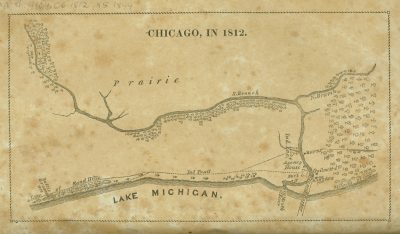Mapping the Life and Death of Jean Lalime

This semester I’ve been working with my Loyola colleagues Amber and Kyle to develop an online exhibit about the life and death of Jean Lalime. Lalime is often billed as “Chicago’s First Murder Victim.” He was a French-Canadian trader who worked in early Chicago as an interpreter between U.S. Troops at Fort Dearborn and the Potawatomi Nation until 1812, when he was killed by rival trader John Kinzie. Later in the 19th century, Lalime’s bones were collected by the Chicago Historical Society, which still holds them today.
In our exhibit, we tell the story of both Lalime’s life and the persistent curiosity about his death that led to his body becoming a museum piece. After much discussion about themes that could unite the many uncertain strands of this story, we decided to emphasize the theme that Jean Lalime is a person who has not rested. Instead, his story is filled with motion, as Lalime traveled far in life and repeatedly in death as his body was buried, reburied, exhumed, and exhibited as a museum relic. During his life, Lalime not only moved from Quebec to Chicago and made long journeys as a fur trader, he also moved between cultures as an interpreter fluent in French, English, and Potawatomi. After his death, Lalime’s bones were moved about Chicago while interpretations of his death moved between claims of cold-blooded murder and Kinzie’s self-defense. By the end of our story, historians and collectors gradually moved to reconsider the display of human remains like Lalime’s bones in museums.
Our exhibit will illustrate the ways that Lalime has not rested using an interactive map that plots Lalime’s physical movement in life and death while relating his changing position in space to the cultural and intellectual movements that have surrounded him. Links will connect the map to significant primary source documents and images that shed further light on his story.
We hope that our exhibit will appeal to multiple audiences. For Chicagoans with a general interest in local history, Lalime’s murder remains not only a vivid tale from the city’s early past, but an example of the cultural tensions during the region’s transition from Potawatomi to United States control. The exhibit may also speak to our peers in public history by presenting a long case study of the changing attitudes toward the care and disposition of human remains in museums. Social media buttons for sharing, linking, or commenting on the exhibit may help promote the story and spark discussion about Lalime as the Chicago History Museum considers how to respectfully put his body to rest.
2 Responses to "Mapping the Life and Death of Jean Lalime":
Thanks for articulating our exhibition idea so well, Josh. Speaking of social media, I wonder of Lalime’s story is one that lends itself to those fictional first-person twitter accounts like these (https://twitter.com/franceswillard and https://uwm.edu/letters-science/1033-2/) where organizations tweet from the perspective of historical figures. Our exhibition is focused on a single person. It’s also organized chronologically (perfect for the Twitter timeline). It would definitely require some finessing to tastefully tweet as a corpse, but it might be a bit more interesting than a traditional social media campaign if we could get it right.
Comments are closed.